

Scrimshaw
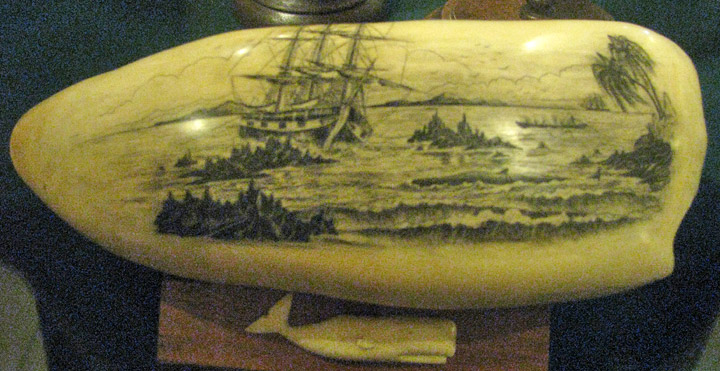
Scrimshaw
Scrimshaw is the name given to handiwork created by whalers made from the byproducts of harvesting marine mammals. It is most commonly made out of the bones and teeth of Sperm Whales, the baleen of other whales, and the tusks of walruses. It takes the form of elaborate carvings in the form of pictures and lettering on the surface of the bone or tooth, with the engravings highlighted using a pigment, or small sculptures made from the same material. The making of scrimshaw began on whaling ships between 1817 to 1824 on the Pacific Ocean, and survived until the ban on commercial whaling. The practice survives as a hobby and as a trade for commercial artisans. A maker of scrimshaw is known as a scrimshander. Scrimshaw is also a surname.
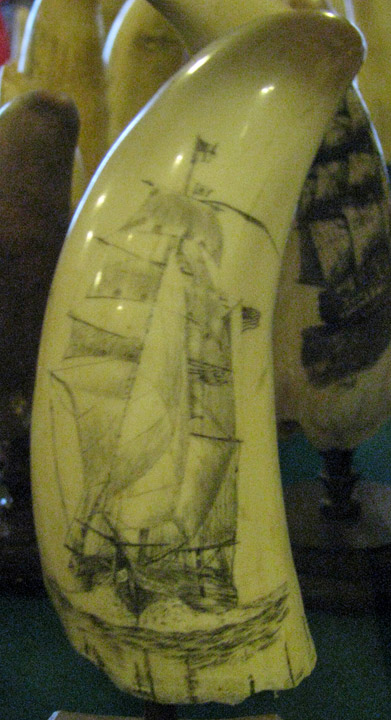
Scrimshaw is derived from the shipboard practice of sailors creating common
tools, and on whaling ships the byproducts of whales were readily available. The
term originally referred to the making of these tools, only later referring to
works of art created by whalers in their spare time. Whale bone is ideally
suited for the task, as it is easy to work and was very plentiful.
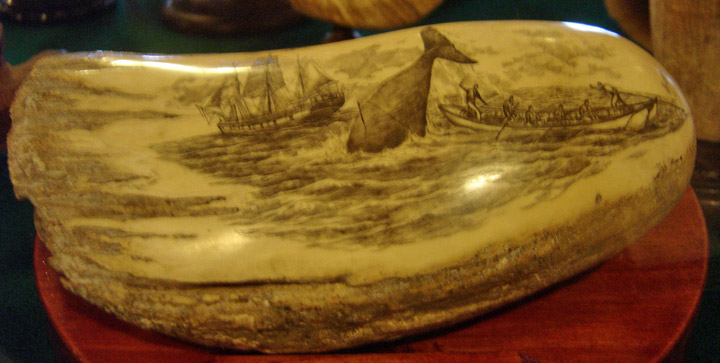
The development of scrimshaw took off after the market for whale teeth, which
was sought by Chinese traders for use in the Pacific Islands (for example the
Fijian market for tabua), was flooded with teeth after a narrative by an
American sailor, Captain David Porter, revealed both the market and the source
of the teeth. Around this time is the earliest authenticated pictorial piece of
scrimshaw (1817). The tooth was inscribed with the following This is the tooth
of a sperm whale that was caught near the Galapagos islands by the crew of the
ship Adam [of London], and made 100 barrels of oil in the year 1817.
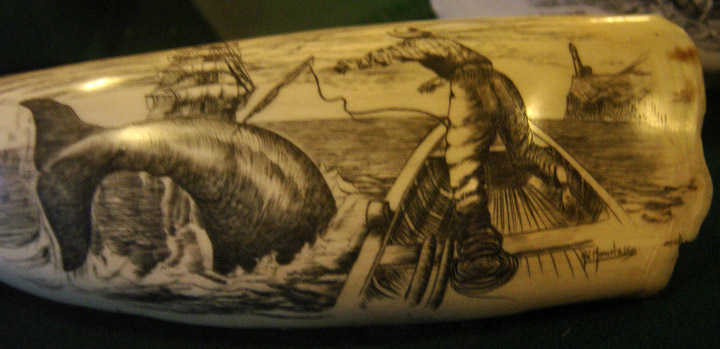
Other sea animal ivories were also used as alternatives for rarer whale teeth.
Walrus tusks, for example, may have been acquired in trade from indigenous
walrus hunters.
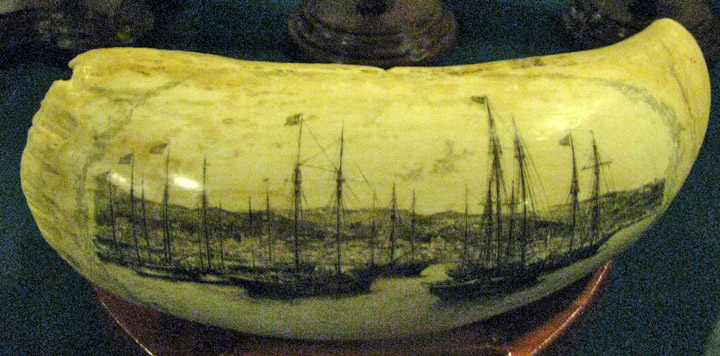
Scrimshaw essentially was a leisure activity for whalers. Because the work of
whaling was very dangerous at the best of times, whalers were unable to work at
night. This gave them a great deal more free time than other sailors. A lot of
scrimshaw was never signed and a great many of the pieces are anonymous. Early
scrimshaw was done with crude sailing needles, and the movement of the ship, as
well as the skill of the artist, produced drawings of varying levels of detail
and artistry. Originally, candle black, soot or tobacco juice would have been
used to bring the etched design into view. Today's artists use finer tools in
various sizes, mostly borrowed from the dental industry. Some scrimshanders ink
their work with more than one color, and restrained polychromed examples of this
art are now popular.
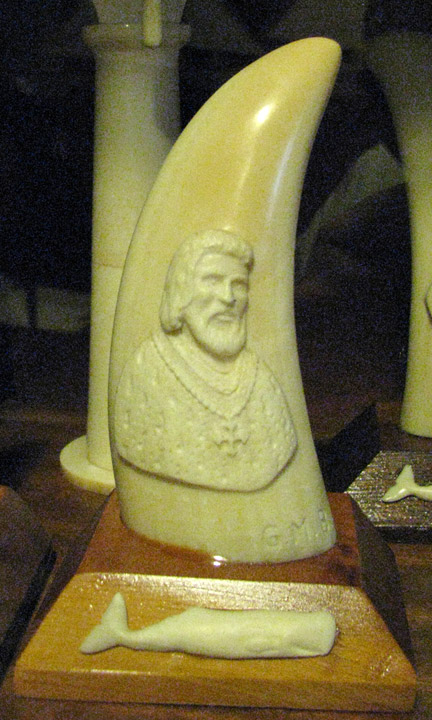
carved into the bone
Originating in an era when sperm whales were initially plentiful only to be hunted to near collapse, scrimshaw no longer is an art form utilizing an easily renewable animal resource, but one that is susceptible to contraband. Now, the Endangered Species Act and international conventions restrict the harvest and sale of ivory to try to reverse the scarcity of ivory-bearing animals.

* Though there are sources of ivory that are sanctioned and legal, poachers in
Africa and other continents where elephants are an endangered species still kill
for their ivory, Elephant ivory has been regulated since 1976 by the Convention
on International Trade in Endangered Species and selling African ivory has been
prohibited since 1989.
* 19th and 20th century scrimshaw, scrimshaw crafted before 1989 (elephant) or
before 1973 (sperm whale ivory, walrus ivory etc.) is legal. It is prohibited
after that year for commercial import in the U.S. under the Marine Mammal
Protection Act.
* Additionally, walrus tusks bearing the Alaska State walrus ivory registration
tag, and post-law walrus ivory that has been carved or scrimshawed by a native
Alaskan Indian (Eskimo), is legally available.
* Finally, any ivory considered ancient, such as 10,000 to 40,000 year old
mammoth ivory, is completely unrestricted in its sale or possession.

Scrimshanders and collectors acquire legal whale teeth and marine tusks through
estate sales, auctions and antique dealers. To avoid illegal ivory, collectors
and artists check provenance and deal only with other established and reputable
dealers. Scrimshaw that is found to have been illegally sourced may be seized by
customs officials worldwide, dramatically loses value and is very hard to
re-sell, as the limited channels through which collectible scrimshaw passes
serves as a check on unscrupulous persons. As with any other fine art form, it
is usually possible for experienced museums, auction houses or other experts to
perceive a fake.
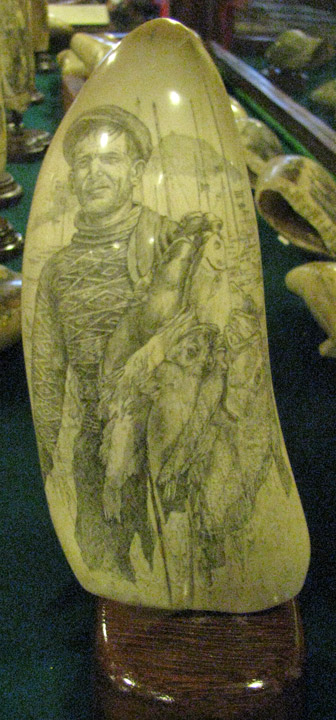
Ivory is a fragile medium; many 19th century pieces were preserved because they
were kept in a barrel of oil onboard ship. Gary Kiracofe, a scrimshander in
Nantucket, MA, advises collectors that if a piece looks dry, one should fill the
center of the tooth with unscented baby oil and allow it to remain until as much
oil as possible is soaked into the microscopic pores of the ivory. Clear paste
wax or high-end car wax will seal the surface after oiling. Bone items are even
more fragile (more fibrous and porous) and may be treated the same way - with a
light clear mineral oil. Organic oils are inadvisable, as they will eventually
hasten discoloration, as on old piano keys subjected to the natural oils in
one's hands.

Professional conservators of art and historic artifacts will generally recommend
against applying any type of dressing (like oil or wax) to organic objects such
as whale ivory. Sensible choices regarding storage and display will preserve
whale ivory best: keep out of direct sunlight, handle with cotton gloves or
freshly-washed hands, and avoid keeping in places with shifting humidity and
temperature. Coating organic objects can induce eventual cracking.

Whale teeth and bones were a highly variable medium, used to produce both
practical pieces, such as hand tools, toys and kitchen utensils, and highly
decorative pieces, which were purely ornamental. The designs on the pieces
varied greatly as well, though they often had whaling scenes on them. For
example Herman Melville, in Moby-Dick, refers to "lively sketches of whales and
whaling-scenes, graven by the fishermen themselves on Sperm Whale-teeth, or
ladies' busts wrought out of the Right Whale-bone, and other skrimshander
articles". Most engravings were adapted from books and papers.
Text from Wikipedia
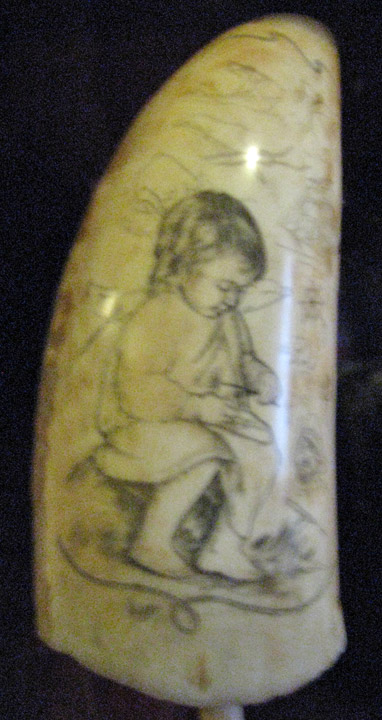
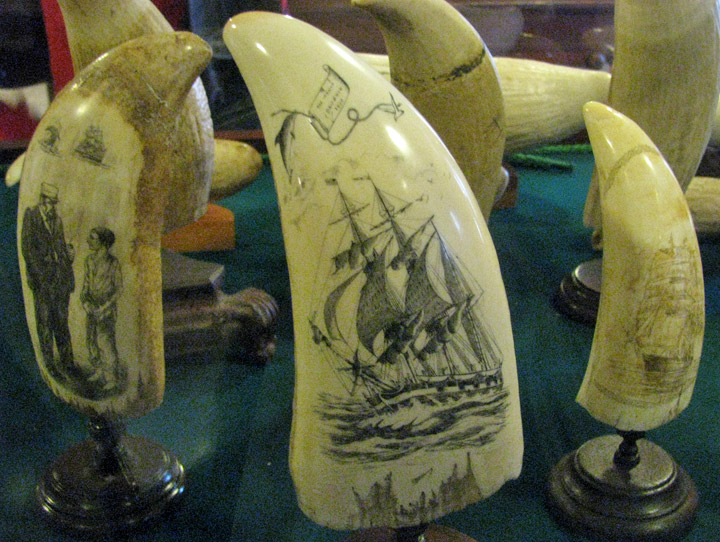
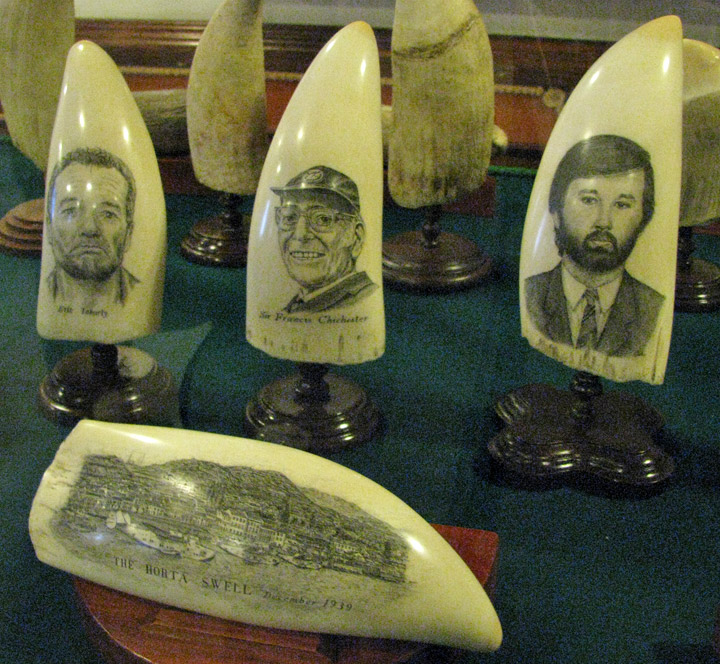
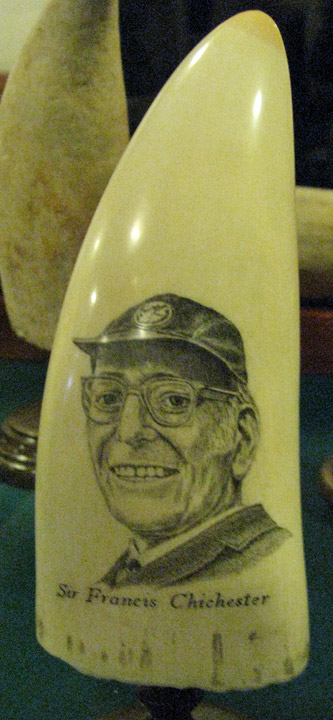
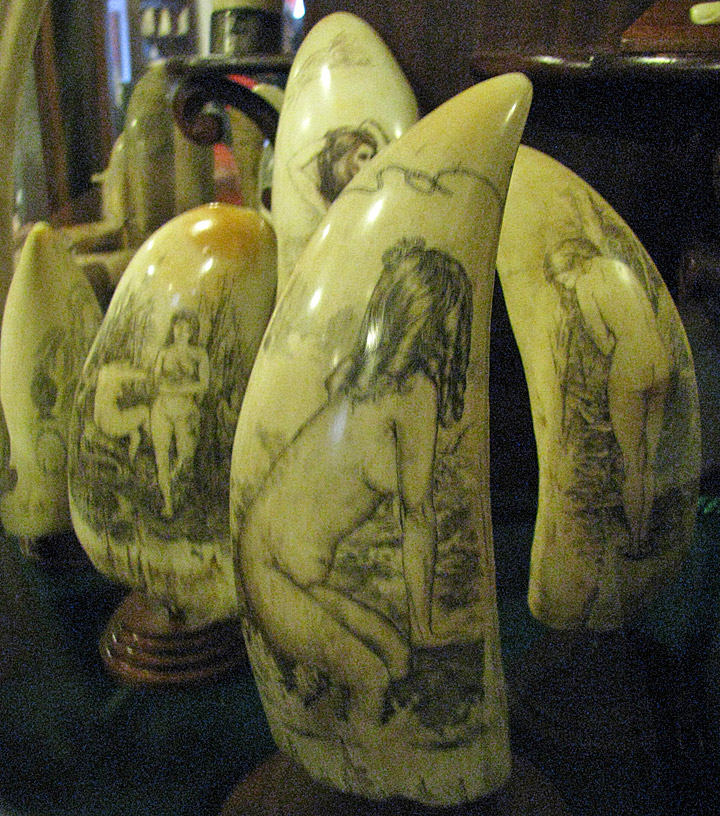

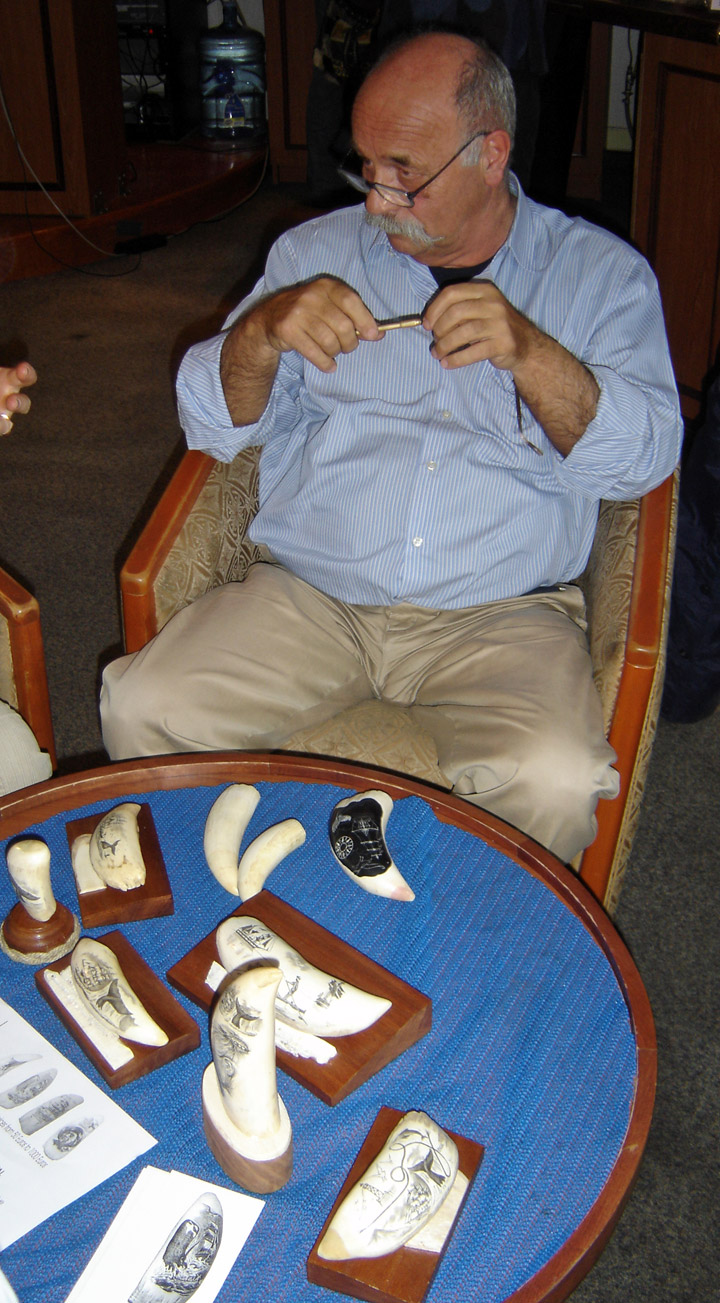
a modern schrimshander who lives on Faial Island